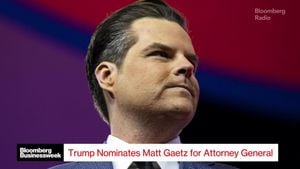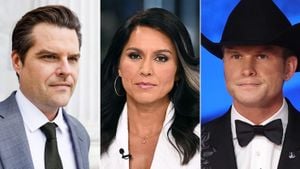When Donald Trump made his return to the presidential race, the ripple effects were felt not just on the political terrain but also within the corridors of economic power, especially at the Federal Reserve. With his unique approach to governance, Trump is poised to shake up the way monetary policy is shaped and enacted, and it has sent economists and political pundits alike scrambling to predict the potential impact.
Let’s rewind to when Trump had his first bite at the cherry back in 2016. He was acclaimed for his unconventional candidacy and, upon taking office, immediately set his sight on the Federal Reserve. Appointing Jerome Powell as chairman seemed to be indicative of Trump's preference for low-interest rates, which he believed would bolster his administration's economic policies. Trump was on record stating his desire for the Fed to keep rates low, aligning with his narrative of economic growth and expansion.
Fast forward to now, following Trump's recent triumph, the Fed wasted no time adjusting its monetary policy. Just two days post-election, they announced a quarter-percent cut to interest rates, startling many who were watching closely. At the same time, Powell firmly expressed his stance during his press conference: he wouldn’t be bullied or swayed by the president. He had no intention of resigning and reiterated the independence of the Federal Reserve, stating, “The president lacks the legal authority to fire the Fed chairman.”
Powell's statement raises some eyebrows considering the heated history between Trump and the Fed, marked by Trump’s previous pressure on the central bank to discuss policy decisions with the presidency. Trump's desire for the Fed to consult with him before making pivotal monetary policy decisions could gallop toward gravely altering the economic dynamics. But here’s where it gets tricky: Powell, who's fiercely protective of the Fed's independence, has hinted at strong opposition to any attempts to encroach on the central bank's autonomy, especially the idea of having to consult with the president—which, as he notes, could lead to increased inflation and dollar devaluation.
The backdrop of this tension isn’t just about personalities. It’s deeply rooted in how interest rates play as economic signals and impacts. Traditionally, politicians favor lower rates, associatively linking them to growth, expansion, and job creation. The Federal Reserve's ability to keep these rates low has allowed the government to amass massive amounts of debt, which many argue is dangerous for economic health. Trump’s past comments reflect this tension, implying his preference for policies to support growth at all costs.
What’s intriguing is the very real possibility of Trump advocating for computational measures to limit the Fed's influence over rates, including initiatives for greater transparency about the Federal Reserve’s operations. His alliances with lawmakers who share similar aspirations could lead to significant changes within the financial regulation framework. There’s also murmurs of Trump potentially backing legislation to audit the Fed, which Powell stridently opposes, fearing it could undermine the institution’s credibility.
This tussle isn’t just about Trump’s promises of economic revitalization; it’s also about whether his leadership style encourages or deters the Fed from acting independently. Renowned economists have often suggested the necessity of the Fed's detachment; their independence is thought to buffer political whims and special interests from interfering actively with monetary policy. Given Trump’s staunch criticism of any tightening or raising of interest rates during his previous administration, the Fed's current positioning is cautious. Since Trump's narrative often revolved around believing politicians could innately understand and set the “correct” interest rate, Powell's technical expertise does come under question.
Central to this conversation is the public’s concern about the booming debt and rising inflation. The sheer scale of federal debt, which is teetering on precarious grounds, often leads critics to echo sentiments about politicians abusing the Fed’s lower interest rate policies to maintain their fiscal agendas at the expense of the American economy. Powell, standing firmly against any erosion of the Fed’s power, understands the potential mayhem of allowing political pressures to influence policy-making. He pointedly articulates the risk: “Politicians usually want low rates,” yet tying monetary policy to political ambitions could spell disaster.
Debt monetization remains at the heart of this dilemma. Many argue, as Ron Paul has extensively noted, the absence of political pressure on the Fed is elusive; historically, presidents have always tried to sway the Fed. Tracing back to before Trump’s tenure reveals this was far from new territory. There’s clear contention here, as political figures like Trump push to assert their influence over pivotal economic decisions. It presents risks and potential inevitabilities—particularly the threat of inflation becoming unmoored.
Despite Trump's polarizing persona, his vision for America—filled with aspirations of fiscal conservatism—could collide head-on with Powell’s approach to fiscal management; this creates fertile ground for conflict and divergent views on responsible governance. If Trump could garner the willingness from Congress, he might be able to catalyze an overhaul of the Fed's operations significantly.
Supporting legalizing alternative currencies, his administration might also challenge traditional fiat systems. Trump’s alignment with cryptocurrencies and precious metals could provide pathways for lightening the inflationary burden many Americans currently face. The coupling of reduced monetary policy authority for the Fed with free-market principles could, for some, present as potential solutions without the overhang of political meddling traditionally associated with governmental interference.
This whole scenario begs the question: what would making money “free again” mean for America? For proponents like Ron Paul, it perhaps signals returning to sound economic principles. Trump’s strategy would likely include cutting government spending, particularly where wasteful expenditures are prevalent, which echoes calls for trimming military and defense budgets. Given the dire situation surrounding inflation and growth, such ideas might gain traction.
While Trump’s intentions can stir spirited debate, the backdrop of monetary policy molded by his stint as president continues to challenge widespread economic stability. His combative approach toward the Fed and its chair’s steadfastness creates high stakes for America’s financial future. Inflation, interest rates, and comprehensive monetary reform all swirl together, hinting at confrontational paths as Trump attempts to maintain control amid potential turbulence.
Overall, the road home for Trump after winning the 2024 presidency is layered with economic intricacies and political frictions. Tuning the national economic orchestra could mean juggling compromises and asserting roles traditionally reserved for financial institutions. With the Fed on the watch and the balance of power shifting continually, the next few months will be pivotal as America witnesses this fascinating interplay of politics and economics.
What most agree on is this—Trump’s approach can reshape American responses to money and fiscal policy, but whether this leads to revitalizing the economy or placing it at greater risk remains a contentious point. The inevitable tensions between presidential aspirations and central bank independence may well dominate discussions for some time to come, setting the stage for potentially unprecedented reforms or upheavals.



